Al-Baqi Cemetery
Jannat al-Baqīʿ (Arabic: ٱلْبَقِيْع, "The Baqi'") is the oldest and the first Islamic cemetery of Medina[1] in the Hejazi[2] region of present-day Saudi Arabia. It is located to the southeast of the Prophet's Mosque, which contains the graves of some of the prophet Muhammad's family and friends. It is also known as Baqīʿ al-Gharqad (Arabic: بَقِيْع الْغَرْقَد, meaning "Baqiʿ of the Boxthorn").[1]
| Al-Baqīʿ | |
|---|---|
ٱلْبَقِيْع | |
 Jannatul-Baqi before Demolition | |
| Details | |
| Established | C.E. 622 |
| Location | |
| Country | Saudi Arabia |
| Type | Muslim |
| Owned by | State |
The grounds hold much significance for Muslims; its status as the resting place of many of Muhammad's relatives and companions establishes it as one of the two holiest cemeteries in Islamic tradition. Many narrations relate Muhammad issuing a prayer every time he passed it. Monuments and mosques built on or near al-Baqi were demolished in 1806 and again in 1926, in accordance with Islamic law regarding idolatry. 21 April, 1926 is considered a Day of Sorrow by muslims who protested against the latter demolitions.
History
When Muhammad arrived at Medina from Mecca in September 622 CE, al-Baqi' was a land covered with Lycium shawii boxthorn trees. According to historical records, after the arrival of Muhammad, the houses of Medina developed near al-Baqi', which was therefore considered as the public tomb. The bramble-growth was cleared and the place consecrated to be the future cemetery of the Muslims who died at al-Madina.[1] Also al-Baqi' was introduced as somewhere whose east side is Nakhl and west side contains houses. In fact, before demolition al-Baqi' was located behind the houses in the city.[3]
During the construction of the Prophet's Mosque, on the site he purchased from two orphan children when he arrived after his migration from Mecca to Medina, As'ad ibn Zurarah, one of Muhammad's companions died. Muhammad chose the spot to be a cemetery and As'ad was the first individual to be buried in al-Baqi' among the Ansar.
While Muhammad was outside Medina for the Battle of Badr, his daughter Ruqayyah fell sick and died in 624. She was buried in al-Baqi'. She was the first person from Ahl al-Bayt (Household of Muhammad) buried in this cemetery.
Shortly after Muhammad arrived from Badr, Uthman bin Maz'oon died in 3 AH (624/625 CE) and was buried in al-Baqi'.[1] He was considered the first companion of Muhammad from the Muhajirun to be buried in the cemetery. He was also called by Muhammad to be the first 'among us to go to the hereafter', and he also called the place where he is buried Rawhā.
When his youngest son Ibrahim died, he commanded that he be buried there also; he watered the grave and called this place Zawrā.[4] As per his command two of his daughters Zainab and Umm Kulthum also buried near the grave of Uthman bin Maz'oon.[5]
Initially, 3rd caliph Uthman[6] was buried in the huge neighbouring Jewish graveyard. The first enlargement of al-Baqi' in history was made by Muawiyah I, the first Umayyad Caliph. In order to honour Uthman, Muawiyah included the huge Jewish graveyard into al-Baqi' cemetery. The Umayyad Caliphate built the first dome in al-Baqi' over his grave. During different times of history, many domes and structures were built or rebuilt over many famous graves in al-Baqi'.
Demolition
First demolition
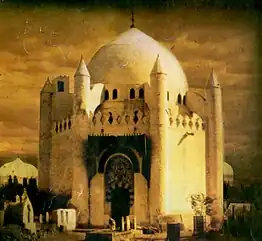

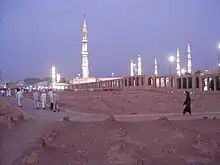
The cemetery was demolished[1] by forces loyal to the Wahhabi-Saudi alliance in 1806 and 1925[7] (or 1926).[1][8]
At the beginning of the Wahhabis of Najd's nineteenth century (1806) control over Mecca and Medina, they demolished many of the religious buildings including tombs and mosques,[9] whether inside or outside the Baqi,[10] in accordance with their understanding of the Islamic doctrine forbidding idolatry.[1] These were razed to the ground[8][11] and demolished due to Wahhabi claims of grave worshipping.[12]
Second demolition
The clan of Saud regained control of the Hijaz in 1924[8] or 1925.[1] The following year King Ibn Saud granted permission to destroy the site with religious authorization provided by Qadi Abd Allah ibn Bulayhid, and the demolition began on 21 April 1926[8] (or 1925)[7][13] by Ikhwan ("The Brothers"), a Wahabbi religious militia.[14] The demolition included destroying "even the simplest of the gravestones".[1] British convert Eldon Rutter compared the demolition to an earthquake: "All over the cemetery nothing was to be seen but little indefinite mounds of earth and stones, pieces of timber, iron bars, blocks of stone, and a broken rubble of cement and bricks, strewn about."[8]
The second demolition was discussed in Majles-e Shora-ye Melli (The National Consultative Assembly of Iran) and a group of representatives was sent to Hijaz to investigate. In recent years, efforts were made by Iranian religious scholars and political figures to restore the cemetery and its shrines.[8] Both Sunni and Shia protested against the destruction[1][13] and rallies are held annually.[1][15] The day is regarded as Yaum-e Gham ("Day of Sorrow").[13] Prominent Sunni theologians and intellectuals have condemned the "unfit" situation of the Baqi cemetery but the Saudi authorities have so far ignored all criticism and rejected any requests for restoration of the tombs and mausoleums.[8]
Burials
For more: Category:Burials at Jannat al-Baqī
Religious Islamic people buried at Al-Baqi'
- Halimah the milk-mother and nurse of Muhammad
- Wives of Muhammad, Sawdah bint Zam'ah, Aisha, Hafsa bint Umar, Zaynab bint Khuzayma, Umm Salama, Zaynab bint Jahsh, Umm Habiba, Juwayriya bint al-Harith, Safiyya bint Huyayy, Maria al-Qibtiyya except Khadijah bint Khuwaylid and Maymunah bint al-Harith who are buried in Jannatul Mualla in Mecca and at Sarif respectively.
- Ibrahim, Muhammad's son by Maria al-Qibtiyya, died in infancy
- Fatima, the daughter of Muhammad, is purportedly buried there, though the location of her grave is disputed.[16]
- Fatima bint Asad, aunt of Muhammad and mother of Ali.
- ‘Abbas ibn ‘Abd al-Muttalib, uncle of Muhammad.
- Umm ul-Banin, who married Caliph Ali after the death of Fatimah and Safiyyah, Atika aunts of Muhammad.
- Hasan ibn Ali, grandson of Muhammad, son of Fatimah bint Muhammad and Ali.
- Zayn al-Abidin, the grandson of Fatima bint Muhammad who is the only adult male that survived the Battle of Karbala because he was sick and could not fight.
- Muhammad al-Baqir, son of ‘Alī ibn Ḥusayn.
- Ja'far as-Sadiq, son of Muhammad al-Baqir.
- Abdullah, son of Jaffar at-Tayyar, who was husband of Zainab, daughter of Ali and nephew of Ali
- (martyrs of Karbala).
- Aqeel ibn Abi Talib, the elder brother of Ali.
- Uthman ibn Affan, early companion, second cousin, third Sunni Caliph. Uthman ibn Affan was at first buried in a Jewish graveyard behind Al-Baqi', but later Muawiyah I extended Al-Baqi' to include Uthman.[17][18]
- Abdulmejid II 1868-1944
Unknown burial locations
- Mohammad Hayya al-Sindhi, Scholar
- Imam Shamil, Muslim leader and freedom fighter from the Caucasus
- Muhammad Sayyid Tantawy, Scholar
- Zine El Abidine Ben Ali, President of Tunisia
- Idris of Libya, King of Libya
- Hasan as-Senussi, Crown Prince of Libya
- Muhammad Zakariya Kandhalawi, Scholar and author of Fazael-e-A'maal
- Rafiuddin Deobandi, Vice-Chancellor of Darul Uloom Deoband
Gallery
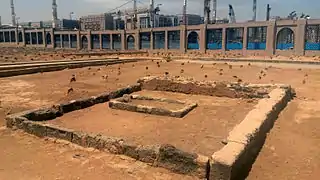 Grave of Halimah
Grave of Halimah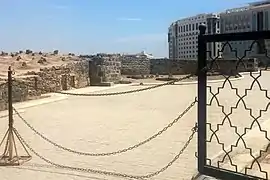 Graves of Fatimah (single grave in front), Hasan, Imam Zain al-Abideen, Muhammad al-Baqir and Jafar as-Sadiq (2nd row left to right, 4 graves side by side), and ‘Abbas ibn ‘Abd al-Muttalib (single grave at right)
Graves of Fatimah (single grave in front), Hasan, Imam Zain al-Abideen, Muhammad al-Baqir and Jafar as-Sadiq (2nd row left to right, 4 graves side by side), and ‘Abbas ibn ‘Abd al-Muttalib (single grave at right)_nabi_1.JPG.webp) Grave of wives of Muhammad, left to right: Maria al-Qibtiyya, Juwayriyya bint al-Harith, Hind bint Abi Umayya, Zaynab bint Jahsh, Zaynab bint Khuzayma, Sawda bint Zamʿa, Hafsa bint Umar, Safiyya bint Huyayy, Ramla bint Abi Sufyan, Aisha bint Abi Bakr
Grave of wives of Muhammad, left to right: Maria al-Qibtiyya, Juwayriyya bint al-Harith, Hind bint Abi Umayya, Zaynab bint Jahsh, Zaynab bint Khuzayma, Sawda bint Zamʿa, Hafsa bint Umar, Safiyya bint Huyayy, Ramla bint Abi Sufyan, Aisha bint Abi Bakr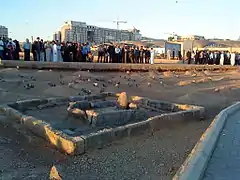 The grave of Ibrahim ibn Muhammad
The grave of Ibrahim ibn Muhammad Grave of Uthman, with the Masjid an-Nabawi in the background, view towards the west. The Green Dome is also visible.
Grave of Uthman, with the Masjid an-Nabawi in the background, view towards the west. The Green Dome is also visible.and_Akil_bin_abi_Talib.jpg.webp) Graves of Abdullah ibn Ja'far and Aqeel ibn Abi Talib
Graves of Abdullah ibn Ja'far and Aqeel ibn Abi Talib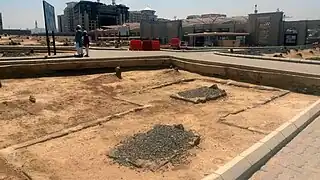 Graves of Malik ibn Anas and Nafi‘ al-Madani
Graves of Malik ibn Anas and Nafi‘ al-Madani_and_other_Imams.JPG.webp) Imam Zain al-Abideen's desecrated grave at Al-Baqi' in Saudi Arabia
Imam Zain al-Abideen's desecrated grave at Al-Baqi' in Saudi Arabia
References
- Werner, Ende (2010). "Baqīʿ al-Gharqad". In Fleet, Kate; Krämer, Gudrun; Matringe, Denis; Nawas, John; Rowson, Everett (eds.). Encyclopaedia of Islam (3rd ed.). Brill Online. ISSN 1873-9830.
- Hopkins, Daniel J.; 편집부 (2001). Merriam-Webster's Geographical Dictionary. p. 479. ISBN 0-87779-546-0. Archived from the original on 23 June 2016. Retrieved 17 March 2013.
- Muhammad Sadiq Najmi. history of tombs of Imam in Baqi and other monuments (in Persian). Mashar. pp. 67–68.
- "Encyclopedia of Islam by the Turkish government".
- Sunan Abu Dawood. pp. https://sunnah.com/abudawud:3206.
- Textual Sources for the Study of Islam, by Knappert, Jan, and Andrew Rippin
- Mohammadi, Adeel (2014–2015). "The destruction of Jannat al-Baqi': A case of Wahhabi Iconoclasm" (PDF). Undergraduate Journal of Middle East Studies. Canada (8): 47–56. Archived (PDF) from the original on 2 August 2019. Retrieved 30 July 2016.
- Bahramian, Ali; Gholami, Rahim (2013). "al-Baqīʿ". In Madelung, Wilfred; Daftary, Farhad (eds.). Encyclopaedia Islamica (Third ed.). Retrieved 2 September 2016.
- "Sahih Muslim 969a, 969b – The Book of Prayer – Funerals – كتاب الجنائز – Sunnah.com – Sayings and Teachings of Prophet Muhammad (صلى الله عليه و سلم)". sunnah.com. Retrieved 18 February 2021.
- Ahmed, Irfan. "The Destruction Of The Holy Sites in Mecca and Medina". Islamica Magazine. No. 15. Archived from the original on 13 July 2011. Retrieved 7 September 2016.
- "History of the Cemetery Of Jannat Al-Baqi". Al-Islam.org. Archived from the original on 10 April 2019. Retrieved 9 September 2016.
- Bahramian, Ali. "Baqi". The Great Islamic Encyclopedia (in Persian). Retrieved 9 September 2016.
- Shahi, Afshin (2013). The Politics of Truth Management in Saudi Arabia. Routledge. ISBN 9781134653195. Retrieved 14 September 2016.
- "The Destruction Heritage in Saudi Arabia" (PDF). The Center for Academic Shi'a Studies. August 2015. Archived (PDF) from the original on 10 April 2019. Retrieved 14 September 2016.
- Hassan, Sara (27 July 2015). "Protests at Saudi Embassy in Washington". American al-Jazeera. Archived from the original on 25 June 2018. Retrieved 7 September 2016.
- Lady Fatima Archived 11 September 2017 at the Wayback Machine, Islamic Insight, Accessed 1 September 2012.
- "Al Baqi Cemetery". Al-Mustafa International University. Archived from the original on 7 November 2017. Retrieved 20 June 2017.
- "History of the Cemetery Of Jannat Al-Baqi". Al-Islam.org. Archived from the original on 10 April 2019. Retrieved 20 June 2017.
External links
- Visitation of Baqi
- The oldest photos of Jannat al-Baqi (in Persian)
- Jannat al-Baqi website
- Map of Jannat al-Baqi
- History of the Cemetery of Jannat al-Baqi
- The Baqi Collection Photos
- Map of Jannat al-Baqi according to Sunni Muslim sources

